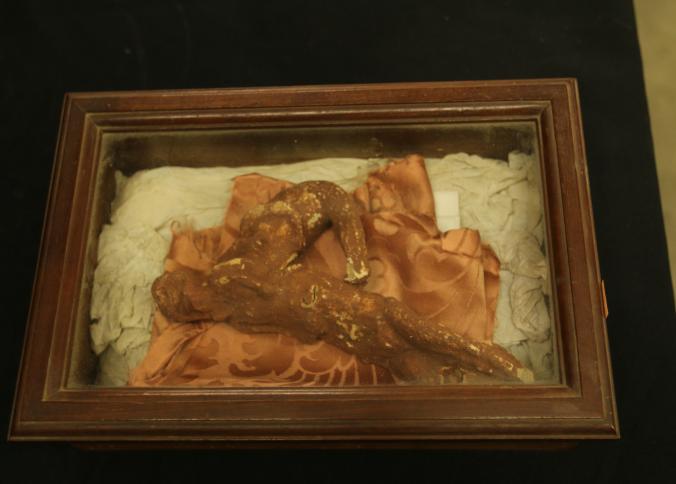Items located in Pleasant Valley, NY. Items include Antique military style cannon having 40.5" wooden wagon wheels, 5" dia barrel, five cannonballs; Ciclofan "sirenetta" quadricycle having green frame, single bench; wooden model ship having four smoke stacks, 16 life boats; 1896 map of the United States and Territories showing the extent of public surveys, Indian, military, and forest reservations; Framed advertisement under glass of Claude Monet exhibit; Luckey, Platt v. Co. six drawer dresser on casters having dovetail construction and more.
Payment is due by Friday, November 10 at 1PM.
Pickup in Pleasant Valley, NY must be completed by Monday, November 13 at 3PM.
All lots sold as is, where is. There is a 15% Buyers Premium for all lots purchased. Payment methods include cash, MC, Visa, Discover or good check. You can make credit card payment online by going to your Member Area and selecting your invoice.
Payment is due by Friday, November 10 at 1PM.
Pickup in Pleasant Valley, NY must be completed by Monday, November 13 at 3PM.
All lots sold as is, where is. There is a 15% Buyers Premium for all lots purchased. Payment methods include cash, MC, Visa, Discover or good check. You can make credit card payment online by going to your Member Area and selecting your invoice.
Auction Info
Items located in Pleasant Valley, NY. Items include Antique military style cannon having 40.5" wooden wagon wheels, 5" dia barrel, five cannonballs; Ciclofan "sirenetta" quadricycle having green frame, single bench; wooden model ship having four smoke stacks, 16 life boats; 1896 map of the United States and Territories showing the extent of public surveys, Indian, military, and forest reservations; Framed advertisement under glass of Claude Monet exhibit; Luckey, Platt v. Co. six drawer dresser on casters having dovetail construction and more.
Payment is due by Friday, November 10 at 1PM.
Pickup in Pleasant Valley, NY must be completed by Monday, November 13 at 3PM.
All lots sold as is, where is. There is a 15% Buyers Premium for all lots purchased. Payment methods include cash, MC, Visa, Discover or good check. You can make credit card payment online by going to your Member Area and selecting your invoice.
Payment is due by Friday, November 10 at 1PM.
Pickup in Pleasant Valley, NY must be completed by Monday, November 13 at 3PM.
All lots sold as is, where is. There is a 15% Buyers Premium for all lots purchased. Payment methods include cash, MC, Visa, Discover or good check. You can make credit card payment online by going to your Member Area and selecting your invoice.
Categories:
Mandrake root from the nightshade family 10" x 5" in glass top box 13.5" x 8.5" x 4"T. A mandrake is the root of a plant, historically derived either from plants of the genus Mandragora found in the Mediterranean region. Mediterranean mandrakes are perennial herbaceous plants with ovate leaves arranged in a rosette, a thick upright root, often branched, and bell-shaped flowers followed by yellow or orange berries. Because mandrakes contain deliriant hallucinogenic tropane alkaloids and the shape of their roots often resembles human figures, they have been associated with a variety of superstitious practices throughout history. They have long been used in magic rituals, today also in contemporary pagan traditions such as Wicca and Odinism. All species of Mandragora contain highly biologically active alkaloids, tropane alkaloids in particular. The alkaloids make the plant, in particular the root and leaves, poisonous, via anticholinergic, hallucinogenic, and hypnotic effects. Anticholinergic properties can lead to asphyxiation. Accidental poisoning is not uncommon. Ingesting mandrake root is likely to have other adverse effects such as vomiting and diarrhea. The alkaloid concentration varies between plant samples. Clinical reports of the effects of consumption of Mediterranean mandrake include severe symptoms similar to those of atropine poisoning, including blurred vision, dilation of the pupils (mydriasis), dryness of the mouth, difficulty in urinating, dizziness, headache, vomiting, blushing and a rapid heart rate (tachycardia). Hyperactivity and hallucinations also occurred in the majority of patients.
More Details
Mandrake root from the nightshade family 10" x 5" in glass top box 13.5" x 8.5" x 4"T. A mandrake is the root of a plant, historically derived either from plants of the genus Mandragora found in the Mediterranean region. Mediterranean mandrakes are perennial herbaceous plants with ovate leaves arranged in a rosette, a thick upright root, often branched, and bell-shaped flowers followed by yellow or orange berries. Because mandrakes contain deliriant hallucinogenic tropane alkaloids and the shape of their roots often resembles human figures, they have been associated with a variety of superstitious practices throughout history. They have long been used in magic rituals, today also in contemporary pagan traditions such as Wicca and Odinism. All species of Mandragora contain highly biologically active alkaloids, tropane alkaloids in particular. The alkaloids make the plant, in particular the root and leaves, poisonous, via anticholinergic, hallucinogenic, and hypnotic effects. Anticholinergic properties can lead to asphyxiation. Accidental poisoning is not uncommon. Ingesting mandrake root is likely to have other adverse effects such as vomiting and diarrhea. The alkaloid concentration varies between plant samples. Clinical reports of the effects of consumption of Mediterranean mandrake include severe symptoms similar to those of atropine poisoning, including blurred vision, dilation of the pupils (mydriasis), dryness of the mouth, difficulty in urinating, dizziness, headache, vomiting, blushing and a rapid heart rate (tachycardia). Hyperactivity and hallucinations also occurred in the majority of patients.
High Bid:
$70.00 – gaithaus
Auction Type: One Lot
Quantity: 1
Bidding has closed on this lot

















